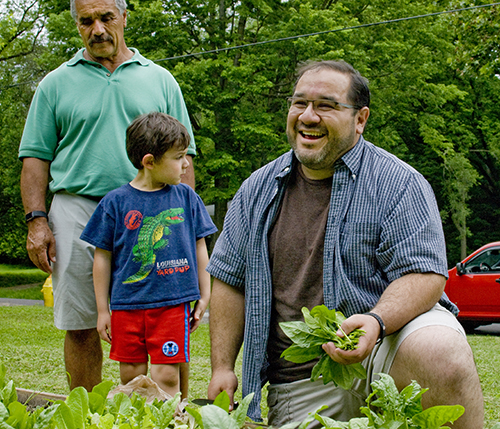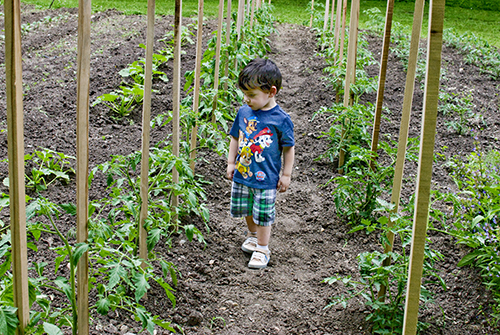
Rigo Diaz, left, stands next to his grandson Tomas, 5, as his son Andy harvests lettuce from a huge garden on his lot on Glendale Avenue. The garden is part of an entrepreneurial undertaking called Urban Acres with a mission to grow vegetables and re-grow the Near North Side. (PHOTO BY CLARE HOWARD)
Diaz is an acolyte of “Strong Towns,” and he sees strong communities throughout the world during his business trips. These neighborhoods have people who know each other, grocery stores with healthy foods, mercado markets, community centers, walking and activity.
Diaz wants that for his Near North Side Community and for all of Peoria.
“We don’t need more $1 million heroes to save Peoria,” he said. “We need more $1,000 heroes.”
Instead of focusing on incentivizing large corporations to relocate to the community, Diaz wants to focus on facilitating small and startup businesses that are home grown.
Without any public funding, Diaz has purchased eight lots in his Near North Side neighborhood, put in vegetable gardens with produce for sale and for donations, and he has closed on the purchase of a building on Spring Street. It was the longtime office of John Ruff, Peoria Podiatry Group. It will become the Spring Board Market with affordable office space for startup entrepreneurs, a commissary and multiple food vendors.
Diaz is working on securing grant funding, but even without a grant, his plans will move forward.
“It will happen faster with a grant. It will be slower if it happens with Diaz family money,” he said.
Last year, Diaz grew more than 600 pounds of produce, selling some, eating some and giving away the remainder. He has no problem with stolen produce.
“How do you steal something I’m giving away?” he said.
In 2018, he began Urban Acres, a business based on growing produce on the empty lots with the dream of someday building homes on the lots that would attract middle class residents back to the Near North Side.
“We need to start attracting middle-income earners back to the Near North Side,” Diaz said. “I felt called to help my community. That’s why my family moved back here from Metamora.”

Augusto Diaz, 2, examines tomato plants as he walks down a row in his father’s vegetable garden. His father Andy Diaz uses no chemical pesticides on his produce. He wants vegetables his children can pop in their mouths with no concern about pesticide residue. (PHOTO BY CLARE HOWARD)
Diaz grew up in the area. His parents, Rigo and Maria Diaz, have lived in the neighborhood for 44 years. Diaz credits his father with being his role model and mentor, recalling how Rigo always helped neighborhood children with bike repairs and starting vegetable gardens. His mother Maria was from one of the first Hispanic families in Bloomington.
“My father always grew peanuts. He’s the Jimmy Carter of the Northend,” Diaz said.
After living in Dallas and Harrisburg, Pa., while working for Caterpillar, the company transferred him back to Peoria. Realtors steered Diaz and his wife to houses out of town and pushed Metamora. They bought a large home in Metamora.
“My wife was not happy there. We were always here (on the Near North Side) on Sundays visiting my parents, and one day we saw a for-sale sign on the beautiful brick cottage next to my parents’ house,” he said.
They bought the house and moved back to Peoria, a 15 minute walk from Caterpillar offices downtown.
That was 2016, and since then Diaz has dreamed nonstop about ideas for improving and strengthening the Near North Side.
He announced recently he plans to run for mayor of Peoria.
“This neighborhood needs a grocery store, but instead of looking for the next Kroger, maybe we can find the next Haddad’s,” he said, noting that Haddad’s owner Mark Wrhel acknowledges profit margins are thin in the small grocery store business but he views Haddad’s as a community service as well as a business.
Diaz said, “We’ve traded community for Amazon. We’ve got to create a movement of people who want to shop local. The millennials are driving the shop local movement. Spend $100 online and get pennies in return for your local community. Spend $100 locally and get $10 in return for your local community. We have to empower local communities. If we stifle community, we will become a ghost town.”
When Diaz started reading about the work of Strong Towns, a not-for-profit organization pushing the same goals, he immediately felt the wind at his back. When he read that developer Kim Blickenstaff invited Strong Towns founder Chuck Marohn to speak in Peoria Heights, Diaz said he felt renewed hope about the future of Peoria.
“Much of what we do is harmful to growth,” Marohn said recently during a dinner presentation at the Trailside Event Center in Peoria Heights.
For example, investing in roads and infrastructure to develop outlying shopping centers and residential enclaves comes with costs that are not recouped for decades or more. And by then, expensive maintenance costs kick in.
This is the “growth Ponzi scheme” Marohn said, with developers reaping profits while communities pay for infrastructure costs, and by the time bonds are paid off, maintenance costs start to eat up revenues.
“Once maintenance kicks in, the cash flow turns negative,” Marohn said. “Growth is an illusion of wealth.”
He calls this an example of cognitive dissonance; positive feedback today blunts the distress of future problems. The suburban growth trend gained momentum after World War II when it was viewed as “the growth engine for America.”
“Now we are seeing the hangover effect,” he said, contending that taking on more debt is not working for cities and neighborhoods. The way to build wealth in cities is modest investments over long periods of time.”
It may sound counterintuitive, but Marohn said the greatest wealth for cities is the core older neighborhoods.
“The greatest source of revenue is from core poor areas that pay more in taxes than they receive in benefits,” Marohn said, noting that mortgages are often not even available for $40,000 inner city homes. “We have to lower the bar for entry (into these neighborhoods.) By lowering the bar for entry, we create more energy in the community.”
Marohn has a formula for seeing potential help for inner city neighborhoods: observe where people are struggling; ask what small things can be done to address that struggle; undertake small, easy steps to address that struggle; repeat that process.
“The result,” he said, “is low risk and high reward.”
For more information on Marohn’s organization, go to www.strongtowns.org.

1 comment for “Urban Acres grows strong communities”